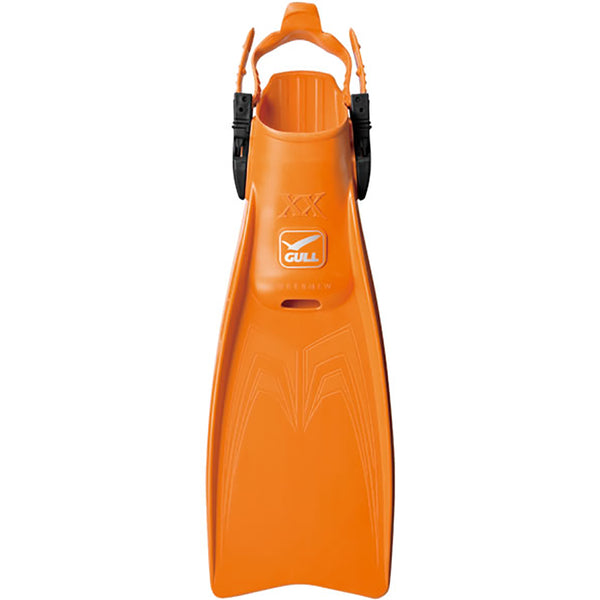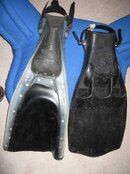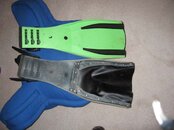You are using an out of date browser. It may not display this or other websites correctly.
You should upgrade or use an alternative browser.
You should upgrade or use an alternative browser.
Modified Flutter versus Frog Kick (from a different point of view)
- Thread starter Doctor Rig
- Start date
Please register or login
Welcome to ScubaBoard, the world's largest scuba diving community. Registration is not required to read the forums, but we encourage you to join. Joining has its benefits and enables you to participate in the discussions.
Benefits of registering include
- Ability to post and comment on topics and discussions.
- A Free photo gallery to share your dive photos with the world.
- You can make this box go away
RobPNW
Contributor
Based on those videos, I definitely do a modified frog kick about 90% of the time.
Robert H. Diver
Contributor
Based on those videos, I definitely do a modified frog kick about 90% of the time.
Same
Eric Sedletzky
Contributor
You can thank the DIR guys for bring back and popularizing (once again) SP Jet fins. When they were forming their protocols there really wasn’t much else out there at the time that was rugged enough with the right geometry to fit the criteria. Jets are made from one material and pretty indestructible. I don’t think they thought about the vents as being a problem or if they did it was just something they had to accept since there weren’t any other options at the time. I do believe some of it was military inspired too since if they were good enough for SEAL teams then they were good enough for them. All the vented Jet fin inspired copies we see now came later and were made in response to the repopularization of the vented SP jet fin.I fully understand that efficiency is not the most important feature in most cases.
My point is that the Jetfins are fins designed with a peculiar goal and optimised for flutter kicking.
As said, here in Europe we had a long tradition of short, stiff and heavy fins, starting from WW2, some of them carefully optimised exactly for the same kind of usage where US tech divers employ the Scubapro Jetfin.
Simply, they do not have venturi channels, which are useless for frog kicking.
So why carrying an amount of rubber which does not provide any thrust during the active part of the kick and causes drag during the recovery?
For modern tech fins without venturi channels, see for example the Dive Rite XT or the Mares XR Power Plana Tec.
There are many others, of course.
Also consider that legs and kicking styles are different. So each diver should search for the fin with the optimal geometry for her/him, not simply choose the same fins that others use.
I remember reading about DIR stuff on forums and everything was about SP Jets as the go to fin for that type of diving, or any tech diving really. It was the ruggedness, the shortness for turning around in confined spaces, and the wide side panel to make backing up easy that made the Jet the preferred fin. If it wasn’t for DIR/tech boom in popularity the SP jetfin would probably be long gone. In fact SP tried to discontinue production several times but the resurgence in popularity by the tech community prevented it. Sales were too good.
The only people who used them when I got into diving were commercial urchin divers because they could beat the hell out of them on the bottom and they don’t need to move around much, and the military because they change their thinking at a glacial pace. There was a pair hanging in the dive shop behind all the other fins and I remeber they were $79.99, and that was full price.
When I was buying my first set of gear at my LDS they steered my towards the brand new (then) Mares Quattro’s.
But it’s weird, I gave the Quattros away to a friend who was getting into diving and bought myself a pair of Jets?? I was into tech at the time. Now I’m deciding I don’t like the Jets anymore and want to try some other fins. @lexvil loaned me some SP Go Sports and I’m going to try those out. I got away from feet up modified frog kicking because I think it’s stupid for open ocean diving, so I’m looking for something that works good for standard good old alternate from-the-hip flutter kicking.
I see SP Jet Fins as kind of like an old big block V-8 engine (think Dodge 440) that’s big and heavy and uses a ton of gas for not as much return in power as you’d hope for.
Eric Sedletzky
Contributor
It’s not only the blade path, it’s the fact that your legs are up and water is hitting the back of your legs which are out of the slipstream.Drag. If you are moving at all, the frog kick blade path results in much higher drag than flutter.
I don't know what "return the energy back to the water" means. Frog's perceived efficiency is almost entirely a byproduct of its low speed. Throttling flutter back to frog speeds results in greater efficiency.
Frog kicks does have advantages, but efficiency is not one of them.
The only reason to ever use a feet up modified frog kick is for non silting. It is not the most efficient kick, it is the best anti silting kick and was developed by cave divers so they wouldn’t silt out caves.
The most efficient kick is one that puts your legs straight back so they are inside the slipstream, whether it’s a short tight flutter or a toe flip dolphin kick or whatever. As soon as your legs/fins get out if your slipstream and cause drag you will slow down.
Actually the legs-up modified frog kicking avoid silt being raised from the bottom, which is a problem only in certain types of caves.It’s not only the blade path, it’s the fact that your legs are up and water is hitting the back of your legs which are out of the slipstream.
The only reason to ever use a feet up modified frog kick is for non silting. It is not the most efficient kick, it is the best anti silting kick and was developed by cave divers so they wouldn’t silt out caves.
The most efficient kick is one that puts your legs straight back so they are inside the slipstream, whether it’s a short tight flutter or a toe flip dolphin kick or whatever. As soon as your legs/fins get out if your slipstream and cause drag you will slow down.
In other caves (or caverns), such as the ones where I was diving for many summers 15-20 years ago (Capo Caccia in Sardinia), this type of legs-up frog kicking is highly deprecated, as it easily causes hitting the ceiling, which is covered by precious red coral.
Here the DM immediately complains with divers who flex their knees raising the fins close to the ceiling.
In those caves I used horizontal scissor kick, which keeps the legs always perfectly straight and avoids silt both from bottom and ceiling.
Each different environment requires different fins and different kicking style.

My understanding is that in the early days of DIR the old non-vented Farallon fins with spring straps were actually preferred. But those were more expensive, not stocked at most dive shops, and were eventually discontinued altogether. Here is a picture.You can thank the DIR guys for bring back and popularizing (once again) SP Jet fins. When they were forming their protocols there really wasn’t much else out there at the time that was rugged enough with the right geometry to fit the criteria. Jets are made from one material and pretty indestructible. I don’t think they thought about the vents as being a problem or if they did it was just something they had to accept since there weren’t any other options at the time. I do believe some of it was military inspired too since if they were good enough for SEAL teams then they were good enough for them. All the vented Jet fin inspired copies we see now came later and were made in response to the repopularization of the vented SP jet fin.
I remember reading about DIR stuff on forums and everything was about SP Jets as the go to fin for that type of diving, or any tech diving really. It was the ruggedness, the shortness for turning around in confined spaces, and the wide side panel to make backing up easy that made the Jet the preferred fin. If it wasn’t for DIR/tech boom in popularity the SP jetfin would probably be long gone. In fact SP tried to discontinue production several times but the resurgence in popularity by the tech community prevented it. Sales were too good.
So the Scubapro Jet Fins were a second-best alternative because they are cheap and available everywhere. Is anyone manufacturing a non-vented hard rubber fin now? I would be happy to buy a pair to try out. The vents seem like kind of a gimmick; I doubt they actually increase efficiency, and I've heard of wreck divers getting hung up on stuff poking into the vent holes.

GULL SUPER MEW XX FIN
Maximizing the resilient properties of rubber, the Super Mew is the most powerful strap fin for scuba diving and skin diving. Boot Pocket In the boot pocket, along sole and high instep minimize lateral slippage of the toe end of the boots. An even better fit is possible if you pair them with...
 www.bigbluescuba.com
www.bigbluescuba.com
Eric Sedletzky
Contributor
Those look like they would really work well.
GULL SUPER MEW XX FIN
Maximizing the resilient properties of rubber, the Super Mew is the most powerful strap fin for scuba diving and skin diving. Boot Pocket In the boot pocket, along sole and high instep minimize lateral slippage of the toe end of the boots. An even better fit is possible if you pair them with...www.bigbluescuba.com
I've done a lot of work on fin design over the years, and thought you'd like to see some of the results from trials I did in 2010. Note that I developed what I call a "scoop" fin, with a flexible inner blade and stiffer outer ribs, that is more efficient than either a flat blade or a split blade. I did these trails for the three types on the same platform. The one blade with the orange inner membrane was done in 1970, and the other Avanti-Scoop is my own fin that I am currently using, showing it against the Jet Fin. The Jet Fin has a disadvantage in that for a flutter kick, the up stroke is mostly drag. I'll show the three fins in a different post.
When talking about fin efficiency, there are two different ways of looking at it. First, is efficiency per kick, and I've defined these pretty well in the spreadsheet. The second is physiological efficiency, in which movement forward is not really looked at, but rather the efficiency of the kick verses amount of energy expended. The frog kick seems better at physiological efficiency, but not at efficiency of movement through the water.
SeaRat
When talking about fin efficiency, there are two different ways of looking at it. First, is efficiency per kick, and I've defined these pretty well in the spreadsheet. The second is physiological efficiency, in which movement forward is not really looked at, but rather the efficiency of the kick verses amount of energy expended. The frog kick seems better at physiological efficiency, but not at efficiency of movement through the water.
SeaRat
Attachments
Similar threads
- Replies
- 3
- Views
- 559
- Replies
- 25
- Views
- 3,550







